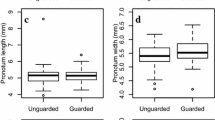Abstract
We studied the mating system of the emerald damselflyLestes sponsa. All males showed intense contact mate guarding by holding the female in tendem during the entire oviposition period. Our findings support the predictions made by Alcock (1994) about the occurrence of intense mate guarding: (1) a high female receptivity after copulation, (2) a high male capacity to resist takeovers, (3) sperm precedence, (4) a high operational sex ratio, (5) a high male density, (6) high access by rivals to mated females, (7) low energy expenditure, (8) a low risk of guarding, and (9) a short interval between copula and oviposition. This indicates a positive cost-benefit balance for this behavior, at least in males. A comparison within the genusLestes suggests that the male-biased sex ratios and the ease with which mated females are detected have been strong selection pressures in the evolution of intense contact mate guarding.
Similar content being viewed by others
References
Alcock, J. (1991). Adaptive mate-guarding by males ofOntholestes cingulatus (Coleoptera: Staphylinidae).J. Insect Behav. 4: 763–771.
Alcock, J. (1994). Postinsemination associations between males and females in insects: The mateguarding hypothesis.Annu. Rev. Entomol. 39: 1–21.
Andersson, M. (1994).Sexual Selection, Princeton University Press, Princeton, NJ.
Andoh, T. (1969). Submerged oviposition ofLestes sponsa.Tombo 12: 27–28.
Conrad, K. F., and Pritchard, G. (1992). An ecological classification of odonate mating systems: the relative influence of natural, inter- and intra-sexual selection on males.Biol. J. Linn. Soc. 45: 255–269.
Cordero, A. (1988). Estudio ecológico de una población deLestes viridis Vander linden, 1825 (Zygoptera: Lestidae).Limnetica 4: 1–8.
Darwin, C. (1859).On the Origin of Species by Means of Natural Selection, John Murray, London.
Dreyer, W. (1978). Etho-ökologische Untersuchungen anLestes viridis (Vander Linden) (Zygoptera: Lestidae).Odonatologica 7: 309–322.
Gower, J. L., and Kormondy, E. J. (1963). Life history of the damselflyLestes rectangularis with special reference to seasonal regulation.Ecology 44: 398–402.
Jurzitza, G. (1969). Eiablage vonChalcolestes viridis in postkopula und Ohne begeleitung durch das Manchen, sowie Gedanken zur Evolution der Fortzpflantzungsverhaltens bei den Odonaten.Tombo 12: 25–27.
Loibl, E. (1958). Zür Ethologie und Biologie der deutschen Lestiden (Odonata).Z. Tierpsychol. 15: 54–81.
Miller, P. L. (1987).Dragonflies, Cambridge University Press, Cambridge.
Miller, P. L., and Miller, C. A. (1981). Field observations on copulatory behaviour in Zygoptera, with a examination of the structure and activity of the male genitalia.Odonatologica 10: 201–218.
Parker, G. A. (1970). Sperm competition and its evolutionary consequences in the insects.Biol. Rev. 45: 525–567.
Parker, G. A. (1974). Courtship persistence and female-guarding as male time investment strategies.Behaviour 48: 157–184.
Rehfeldt, G. (1992). Impact of predation by spiders on a territorial damselfly (Odonata: Calopterygidae).Oecologia 89: 550–556.
Robert, P. A. (1958).Les libellules, Delachaux & Niestlé, Paris.
Smith, R. L. (ed.) (1984).Sperm Competition and the Evolution of Animal Mating Systems, Academic Press, New York, pp. 251–290.
Souroukis, K., and Cade, W. H. (1993). Reproductive competition and selection on male traits at varying sex ratios in the field cricket,Gryllus pennsylvanicus.Behaviour 126: 45–62.
Thornhill, R., and Alcock, J. (1983).The Evolution of Insect Mating Systems, Harvard University Press, Cambridge, MA.
Tsubaki, Y., Siva-Jothy, M. T., and Ono, T. (1994). Re-copulation and post-copulatory mate guarding increase immediate female reproductive output in the dragonflyNannophya pygmaea Rambur.Behav. Ecol. Sociobiol. 35: 219–225.
Utzeri, C., Falchetti, E., and Raffi, R. (1987). Adult behaviour ofLestes barbarus (Fabricius) andLestes virens (Charpentier) (Zygoptera: Lestidae).Fragm. Ent. Roma 20: 1–20.
Waage, J. K. (1986). Evidence for widespread sperm displacement ability among Zygoptera and the means for predicting its presence.Biol. J. Linn. Soc. 28: 285–300.
Yamamura, N. (1986). An evolutionary stable strategy (ESS) model of postcopulatory guarding in insects.Theor. Pop. Biol. 29: 438–455.
Author information
Authors and Affiliations
Rights and permissions
About this article
Cite this article
Stoks, R., De Bruyn, L. & Matthysen, E. The adaptiveness of intense contact mate guarding by males of the emerald damselfly,Lestes sponsa (Odonata, Lestidae): The male’s perspective. J Insect Behav 10, 289–298 (1997). https://doi.org/10.1007/BF02765561
Received:
Revised:
Issue Date:
DOI: https://doi.org/10.1007/BF02765561




